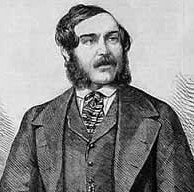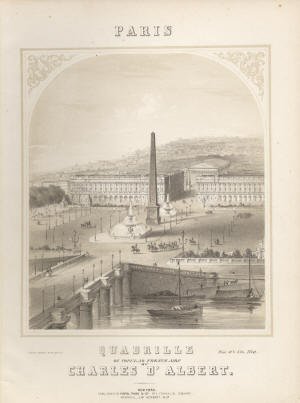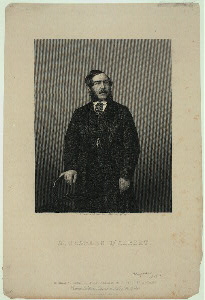Albert, Charles d' - Les Boulevards - Ave Maria
 for piano
for piano
year of composition / 1st publication: s.a.
 | Composer: Charles d'Albert (1809-1886) aliases, aka: Charles Louis Napoléon d'Albert Country of origin / activity: | |
| Text author: N/A - instrumental only | ||
| Arranger / Editor: N/A |
| MIDI | MP3 | VID | First name | Last name | Birth | Death | comp | ID # | Title | Voicing | Instrumentation | |
|---|---|---|---|---|---|---|---|---|---|---|---|---|
| 1 | 1 | 1 | 1 | Charles | D'Albert | 1809 | 1886 | Les Boulevards; based on "Ave Maria" | NV | piano | ||
| 0 | 0 | 0 | 0 | E. | Albert | 1857 | Ave Maria | soprano solo | ? | |||
| 0 | 0 | 0 | 0 | J | Albert | Ave Maria | TTB / soprano solo | ? |
Paris. Quadrille on Popular French Airs No.3 Les Boulevards - "Ave Maria" Publ. Firth, Pond & co.
Available documentation:
Score: courtesy of Lester S. Levy collection of sheet music |  |
Lyrics:
| none - instrumental only |
| MIDI: | MP3: not available |
| Play / stop MIDI |
Recording:
| not available |
Video - posted on YouTube:
| Uploaded by PSearPianist on Oct 26, 2011 Introduction - La Place de la Concorde - Les Fontaines;; 1 (Pantalon) - Les Tuileries ('Mire dans mes yeux tes yeux'); 2 (Êté) - Les Champs Elysees ('Son Nom'); 3 (Poule) - Les Boulevards ('Ave Maria'); (video is set to start at 2'15"); 4 (Trenise) - Le Palais Royal ('Ma Brunette'); 5 (Finale) - Le Jardin Mabille ('La Ronde de Nuit'). ------------------------------------------------------------------------------- Charles Louis Napoleon d'Albert (1809-86) was of French stock, but lived and worked in England. He was a popular composer of quadrilles, waltzes, galops etc., but his main claim to fame today is probably being the father of the far better-known pianist, composer and Liszt pupil Eugen d'Albert. I recorded this piece at the request of a viewer. Following a very short introduction (depicting the scene shown on the cover illustration), there are the traditional four sections of a French quadrille (with a Trenise instead of a Pastourelle). Each piece has the title of a Parisian location, and is subtitled with the French popular song used. Thank you, Phillip Sear, for making this video! |
Internet references, biography information:
| not available | |
| http://www.musicweb-international.com/garlands/19th.htm | |
| Charles d'Albert (or, to give him his full name Charles Louis Napoleon d'Albert: he was of French émigré stock but worked in England most of his life and fathered Eugene, composer of the opera Tiefland and much else?) was astonishingly prolific. At one time he had some 300 works in print, for piano or piano duet. From a publisher's catalogue of around 1860 we note that piano solo copies were available of 81 quadrilles, 76 waltzes, 64 polkas and 48 galops and miscellaneous dances, A large proportion of each category also had piano duet versions and of them respectively 44, 32, 23 and 13 were available in full orchestral arrangements and a few were also scored for military band. D'Albert's quadrilles included Bomarsund, Sebastopol and many based on operatic melodies from e.g. Robin Hood (by Macfarren) Marta (Flotow) and seemingly almost every Verdi opera produced up to that time. His waltzes included Rifle Corps, Chant d'Amour Robin Hood (again!), Nymph of the Wave, Rosalinda, Distant Shore and Star of the Night with again many operatic arrangements. From his polka titles we may mention Rifle Corps, Great Eastern, Sultan (I heard this recently in a modern arrangement and quite a catchy number it is, too), Coquette, Delhi, Invitation, Ladies' Polka, Linnet Polka, Camp Polka, Drink Puppy Drink and Prince Albert's Polka; galops were danced to tunes entitled Overland Mail, Pélissier, Submarine, Garibaldi, Mount Etna and The Rink; and miscellaneous dance music included various schottisches, The Olivette, Rip Van Winkle, and Pirates of Penzance lancers, a piece intriguingly entitled La Tempête and a French country dance, La Carillon de Dunkerque. The topicality of some of the above titles need not be explained, but Bomarsund and Sebastopol were Russian Crimean War fortresses, the Rifle Corps dances celebrated the revival of the rifle volunteer movement in 1859-60, Delhi was besieged during the Indian Mutiny (1857) and Pélissier was a French C-in-C in the Crimea. | |
New York Public Library digital gallery: | |
 | |
Page last modified: November 16, 2013
 avemariasongs
avemariasongs org
org